The Bloomsbury Group: Britain's most stunning bohemian gardens
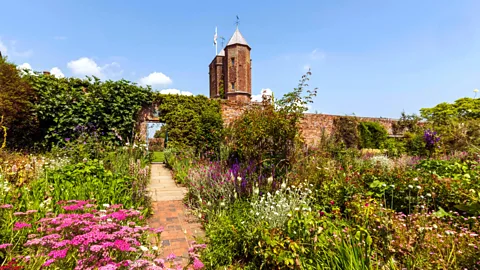 Alamy
AlamyAn exhibition at London's Garden Museum reveals the vital role nature played in the lives and work of Britain's radical creative collective, the Bloomsbury Group.
Gardens are probably not the first thing that spring to mind when it comes to the women of the Bloomsbury Group. But as Gardening Bohemia: Bloomsbury Women Outdoors at London's Garden Museum reveals, they played a vital role in the creative lives of the writers Virginia Woolf and Vita Sackville-West, Woolf's artist sister Vanessa Bell and the arts patron Lady Ottoline Morrell. Although very different in scale and ambition, their gardens were all places of sanctuary and experimentation where the women and their circles of friends and family were free to explore their innovative, and often radical, ideas – around creativity, life and love.
"In very tangible ways, but also in some more ephemeral ways, we can really see how much their gardens shaped their work," says the writer and academic Claudia Tobin, who curated the exhibition.
The connection is perhaps most evident at Charleston, the Sussex farmhouse that Vanessa Bell and her lover Duncan Grant retreated to in 1916, during World War One.
Bustling with family members and friends, it was a sociable and collaborative hive of creativity.
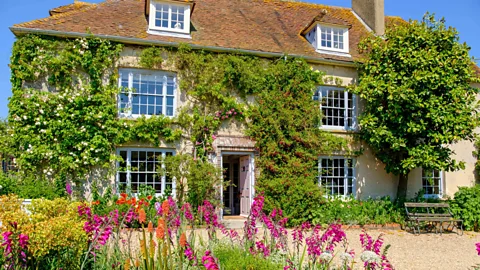 Alamy
AlamyThe layout of the garden was designed by the painter and critic Roger Fry, with bold colours and simplified abstract designs. Fry was in part influenced by the Arts and Crafts garden designer Gertrude Jekyll who had worked on his own garden. "He is taking ideas from the Arts and Crafts movement and infusing them with his own modernist vision," explains Tobin.
What Fry had begun, Bell and Grant continued. Their creative spirit spilled out into the garden and flowed back into the house. Favouring vibrant colours and unusual forms, they had a particular fondness for Red Hot Pokers, and the flower can be seen in many of their paintings. They made mosaic tiles to decorate the pond and various sculptures that were placed in the grounds. Having created such a delightful space, they frequently used it as an outdoor studio, or selected flowers and vegetables to appear in still-lifes. These natural elements also spread throughout Charleston's unique interior design.
"You can see the way these decorative motifs blossomed out beyond the paintings, across the walls and on to walls, tiles and door panels – everything is this exuberant decorative impulse," says Tobin.
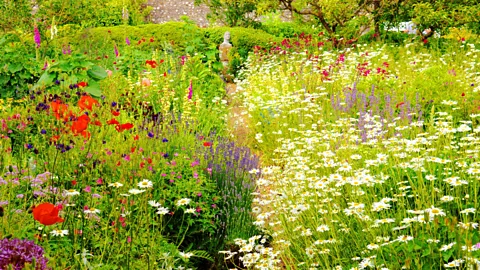 Getty Images
Getty ImagesThe garden was also a safe space for Bell, Grant and their circle to explore their unconventional approach to life and love. The writer David Garnett, a sometime lover of Grant's (both Bell and Grant were bisexual) was a regular visitor, as was Clive Bell, Vanessa's husband, with whom she remained on good terms. During the war both Grant and Garnett were pacifists and were able to do farm work there in lieu of going to the front.
A 'living work of art'
Lady Ottoline Morrell's garden at Garsington Manor was an equally vibrant and unconventional place, albeit on a somewhat grander scale. The Morrells bought the house in 1914 and Ottoline redesigned the gardens, taking inspiration from those at the Villa Capponi in Italy, which she had visited as a young woman. In her memoirs, she describes the formal flower garden as being "like a coloured, sweet-smelling carpet", as well as the "monastic fish-ponds, surrounded by Italian statues" and green paths "where peacocks trailed their long tails".
In this enchanting space Morrell gathered around her groups of artists, writers and intellectuals who took part in long weekends of dancing, debating, performing and bathing. Katherine Mansfield, DH Lawrence and Aldous Huxley were all visitors. She thought of the garden as a kind of living work of art, and in return it inspired numerous literary and artistic interpretations, not all of them complimentary.
 Alamy
AlamyHuxley mercilessly satirised Morrell's eccentricities in his novel Chrome Yellow. Thankfully, Morrell felt that Mansfield was more attuned to the garden's aesthetic delights. In the letters they exchanged, Mansfield described an imagined story set there: "a kind of, musically speaking, conversation set to flowers".
"She was collecting people and bringing them together in different constellations and being a patron, supporting artists when they were in difficult circumstances," says Tobin. Mark Gertler became a kind of artist in residence, setting up a studio there and painting the gardens, although his somewhat sombre paintings devoid of people aren't really representative of Garsington's hedonistic atmosphere.
More like this:
• Six extraordinary gardens around the world
The liberated nature of the place is more evident in a photograph of the artist Dora Carrington playfully posing next to a statue while entirely nude. Carrington herself commented on the sense of freedom she and Mansfield felt heading out into the moonlit garden, clothed this time but wearing trousers, a highly unconventional form of attire for women at the time.
Virginia Woolf's garden at Monk's House in the village of Rodmell was a much calmer environment. A cherished sanctuary away from the hustle and bustle of London, where Woolf delighted in weekends of "no talking" when she could enjoy the garden's "green tunnels" without interruption.
Although it was in a fairly rudimentary state when Virginia and her husband Leonard bought the house in 1919, she was already envisioning what it could be. "The point of it is the garden… this is going to be the pride of our hearts," she enthusiastically wrote to a friend.
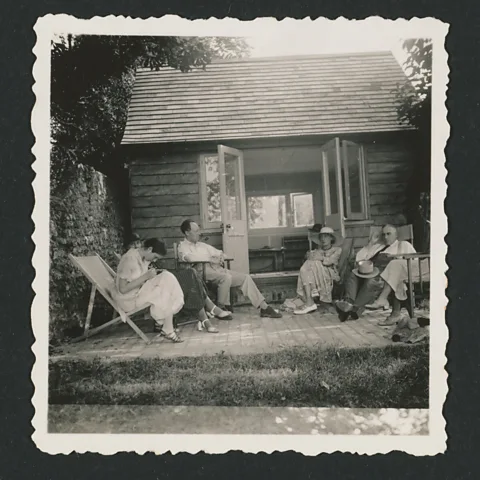 Houghton Library, Harvard University
Houghton Library, Harvard UniversityLeonard was undoubtedly the more green-fingered of the pair, but Virginia delighted in the collaborative nature of working in the garden. The couple would often toil happily together in the flower beds until evening, ending up "stiff and scratched all over", with "chocolate earth under our nails", she recalled. "I think that sense of intimacy and shared space was really important," says Tobin.
'A beautiful escape'
Over the years, the garden developed to include an Italian garden, dew pond, terrace and bowling lawn. And of course, her very own garden "Room of One's Own" – a writing hut nestled in the orchard where many of her most important novels and essays were written. Woolf would head there every morning to write, and Tobin believes her environment undoubtedly seeped into her work.
"I do think it fed indirectly into her novels, not in a literal way of describing flowers, but there's a sensory intensity to a lot of her writing about the natural world, particularly in her most experimental novel The Waves. There are some extraordinary passages where she writes about the natural world from a child's perspective," she says.
Tobin believes Woolf's relationship to nature was "therapeutic". "She wrote about how her mind settled there. It was necessary to her, and particularly necessary to her in periods of mental health crisis, of which sadly there were many," she says.
 Bolton Council. From the collections of Bolton Library and Museum Service
Bolton Council. From the collections of Bolton Library and Museum ServiceThe importance of the garden to Woolf is evidenced by the fact that after she tragically killed herself in 1941, her ashes were buried under an elm tree there, one of a pair referred to as Virginia and Leonard.
The gardens of Woolf's sometime lover Vita Sackville-West at Sissinghurst Castle are of course some of the most celebrated in England. Unlike Bell, Woolf and Morrell, Sackville-West was a skilled garden designer in her own right, as well as a novelist and poet. Her combined talents and sensibilities resulted in a truly unique aesthetic.
"One feels like an artist painting a picture… putting in a dash of colour here, taking out another dash of colour there, until the whole composition is to one's liking," she wrote.
Her "compositions" were a series of themed gardens – the Rose Garden, Cottage Garden, Herb Garden, Spring Garden and, perhaps most famously of all, the White Garden – each envisaged as a botanical "room" providing a stunningly beautiful escape from the world.
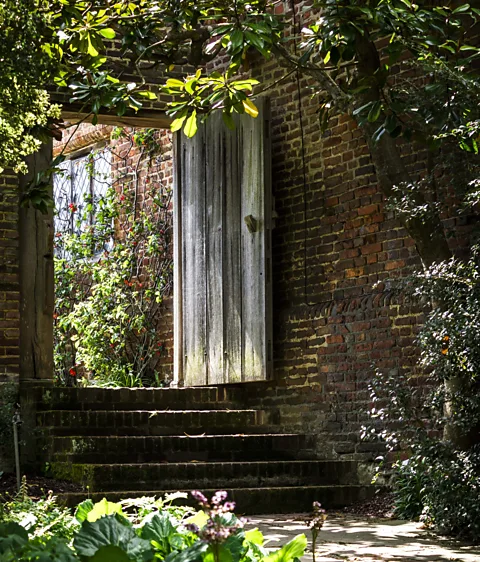 Getty Images
Getty Images"I think her romanticism and her sense of poetry combined with her sense of colour was really distinctive," says Tobin. "It's a combination of a lot of different poetic and cultural references that give it that really special feeling."
Like Woolf, the garden also fed Sackville-West's literary imagination. "With Vita, her writing and her garden were very symbiotic," says Tobin. She was a very practical gardener and the garden itself is "very much present throughout her poetry and novels, and it's often a character in its own right".
This is particularly evident in her poems Sissinghurst and The Garden. Tobin believes that the latter, published just after World War Two, was "her poem of survival, but lived through the garden. It's her own garden but it's also a broader universal meaning of the garden."
Although Garsington Manor is now privately owned, the houses and gardens at Sissinghurst, Charleston and Monk's House are all open to the public, allowing us to wander in the footsteps of the Bloomsbury women, appreciate their enchanting visions and perhaps gain a little inspiration ourselves.
Gardening Bohemia: Bloomsbury Women Outdoors is at London's Garden Museum until 29 September 2024.
--
If you liked this story, sign up for The Essential List newsletter – a handpicked selection of features, videos and can't-miss news, delivered to your inbox twice a week.
